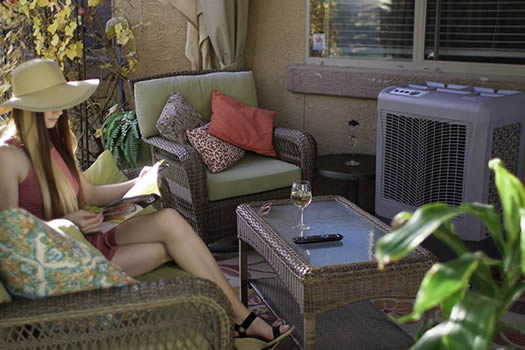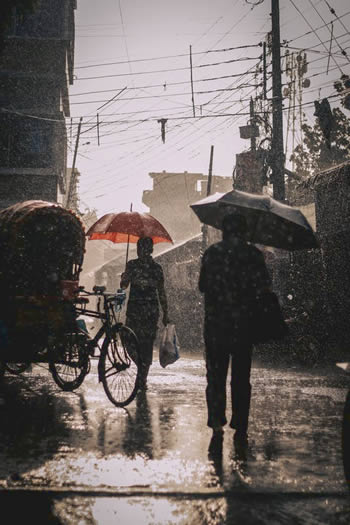Evaporative Coolers: Pros and Cons
When you're looking for a low cost solution to keeping cool this summer, one type of device stands out. Check out evaporative coolers, pros and cons and why you should or should not buy one.
Let's face it, energy costs are continuing to rise year on year without any sign of abating any time soon. The need to try and save energy wherever possible is high on the list of household budget calculations all across the country.
High temperatures in summer means high electricity bills for running the air conditioning to make life bearable indoors. However, is there a cheaper-to-run alternative?
Yes there is! Evaporative coolers cost a fraction of AC to run.
However, being able to take advantage of this type of cooling solution depends on where you live. I'll elaborate by highlighting the pros and cons of this exceptionally desirable cooling device and what you need to make it work for you.
The Advantages of Evaporative Coolers
 I'll begin by listing the main advantages of these great coolers and describe what the benefits are:
I'll begin by listing the main advantages of these great coolers and describe what the benefits are:
Cheap to Run
There's no denying one of the biggest attractions of evaporative (swamp) coolers is their low running costs.
A typical mid-range portable model can use as little as just 50 watts or as much as 200 watts depending on its output rating. Compare that to a comparable size portable air conditioner that can use between 1,000 and 2,00 watts to produce a similar level of cooling and the savings are obvious.
Why Evaporative Coolers Cost So Little to Run
Evaporative or swamp coolers use so little electricity because they have very few internal electrical components. The biggest energy hog is the internal fan that blows air across the moist medium to produce cooling by evaporation.
Yet even powerful fans only use 100-200 watts of electricity. The rest of the electrical usage comes from low consumption components like the small electric motor that moves the swinging louvers and the tiny circuit board in the control panel that controls the timer, power setting and visual display.
Compare that with an air conditioner that has to run the mechanical refrigeration process including the energy hog compressor and heat exchange that produces a lot of heat that needs to be exhausted out of the building. All this mechanical work sucks well over a kilowatt or two of electricity out of the grid and it all has to be paid for!
No Exhaust Vent Required
You may have heard some variation of the promotional blurb about a vent free or ventless portable air conditioner, no exhaust vent hose required on offer in a hardware store or online someplace.
Well, what they're really describing is not an air conditioner at all, but this article's featured device, the good old swamp cooler!
Evaporative (or swamp) coolers don't need any form of exhaust vent hose because there is no hot air to be vented to the outside, unlike air conditioners that produce about as much hot air as they do cold.
AC Vent Hose
You've doubtless seen a portable AC hooked up to a special window fixing kit with a long corrugated plastic hose connecting the back of the AC unit to the window. That's to get rid of the hot air that you most definitely do not want blowing into the room that you're trying to cool down!
Well, since swamp coolers don't have a refrigeration process going on inside them, there is absolutely NO hot air at all. Just cold, moist air blown out the front of the unit, produced by passing room temperature air from the back through a wet medium to create evaporation.
That evaporation produces a cooling effect just the same way as a breeze cools your skin down when you perspire! So these coolers have no vent hose to hook up to anything, making them truly portable!
Ecologically Friendly
Another major benefit of swamp coolers is that because they use so little electricity in the cooling process, they are not drawing much of it from the grid.
That means less fuel needs to be burned to produce that electricity for the evaporative cooled household. That means a whole lot less pollution as well as less consumption of finite fossil fuel reserves (until a better, cleaner and less polluting electricity generation method can replace it).
Another environmental benefit is the lack of refrigeration mechanical components and refrigerant gas, all of which is ecologically damaging. Remember, most old, discarded air conditioners and swamp coolers end up in landfill sites and not recycled like they should be in an ideal world.
Better Internal Air Quality
It may not be something that you're too familiar with, but the indoor air quality can be affected by air conditioning. This becomes noticeable by sufferers of dry eyes, dry, itchy skin and respiratory problems brought about by the excessively dry air.
No More Dry Air
Swamp coolers don't dry the air. They actually humidify the air, making breathing easier and no dry eyes or skin!
Plus, air conditioners require that all doors and windows are closed, meaning they constantly recycle the same stale air inside a room for you to breathe. Swamp coolers require constant air movement by opening windows and doors, so the air is constantly replenished with fresh air!
Indoor and Outdoor Use
Who doesn't enjoy having some friends round for a barbecue or get together outside on the patio or around the pool in summer?
The only problem is that it can get very hot out there, unless you can keep getting in and out of the pool. This problem can easily be remedied by placing a swamp cooler out on the patio with the guests to send a blast of cold air in their direction to keep the cooler and more comfortable.
Outdoor Use Economics
While the same could be done with even the best portable air conditioning units, the big problem would be the crazy expense and waste of a lot of energy, making it economically prohibitive.
However, since swamp coolers use so little energy, a big cooler can be placed outside to keep everyone cool without wasting huge amounts of electricity. These coolers produce cold air whether they are placed indoors or outdoors as long as the humidity level is not too high.
On that last point, I'll let it lead me on to the disadvantages of these amazing coolers
The Disadvantages of Evaporative Coolers
 It's unfortunate, but there are a couple of downsides to these coolers that need to be covered here, especially the first one that I'll get into now.
It's unfortunate, but there are a couple of downsides to these coolers that need to be covered here, especially the first one that I'll get into now.
Humidity Stops Swamp Coolers Cooling
As mentioned near the start of this article, it depends on where you live as to whether you can take advantage of the many clear benefits of evaporating cooling.
One of the major problems that prevent their use is areas with high humidity.
Since these coolers rely on the evaporation process to produce cold air, if the amount of moisture already present in the air is high or at saturation point, little to no more moisture can be absorbed by the air. That stops the cooling effect of evaporation, which only works when the warm air that is trapped in the tiny moisture droplets created by evaporation can be absorbed into the air.
High humidity levels literally stop swamp coolers in their tracks, because already saturated air cannot receive any more moisture to create the cooling effect. You may have experienced this in very hot, humid weather when you feel excessively hot and uncomfortable despite perspiring profusely but not feeling any cooling from the air.
The main caveat here is that if you do happen to live in a highly humid climate, you are unfortunately limited to making use of air conditioning to keep you cool. While it does cost more to run, the extra expense can often be justified for a comfortable indoor environment.
If you intend using individual cooling units, you might want to check out my article on fully self-evaporating portable air conditioners that are more efficient and need less maintenance than regular units.
Alternatively, you could take a look at my article covering ductless mini split air conditioners for larger installations covering several rooms in a house of office space.
Indoor Humidity Levels
A similar effect is created when a swamp cooler is run in a closed space with no ventilation. As the cooler runs and continuously evaporates more and more moisture, the air becomes artificially saturated and as a result, the cooler stops cooling.
This is a problem experienced by a number of owners that erroneously believed their cooler had stopped working because it was faulty. In reality, simply opening a window a crack either end of the enclosed space to create a cross draft would have allowed the cooler to carry on cooling!
Important Tip: Always keep two or more windows open in a building being cooled by an evaporative cooler to allow indoor air to be recycled with the drier, outside air to enable the cooler to maintain its cool air output!
A Swamp Cooler is Not an Air Conditioner
Another "con" or downside to these coolers is more one of expectation than real world actual operation. It is that of expecting it to cool a room or a building the same way an air conditioner does.
However you look at it, a swamp cooler is NOT an air conditioner. The two have entirely different ways of creating cold air.
Air conditioners dry the air as well as cool it, making it feel colder, faster. This process works in a similar way to the inside of a domestic refrigerator, just in a much larger area and using a much greater amount of energy to produce the cooling result.
Evaporative coolers simply evaporate moisture, creating cold, moist air. It feels cooler when you are right in front of the unit of course, but the whole room is reduced in temperature. However, there is a lower limit to the amount a cooler can reduce the temperature by and it will not make a room as cold as an air conditioner.
Summing Up
This is something to be aware of when considering buying an evaporative cooler once you have determined that your local climate has low enough humidity (less than 50% is ideal). It will keep you cool, but just not as cold as air conditioning is capable of.
Lastly, remember you don't need to make it so cold in a room that it feels like the Arctic and you have to put on thick jumpers to get comfortable!
Evaporative coolers can reduce the internal temperature by as much as 20-30 degrees depending on the ambient temperature and the outside weather conditions. Most of the time this is plenty cool enough to keep you feeling comfortable during the hot days and evenings of summer, which is all you really want, right?
Article Posted: March 1, 2021